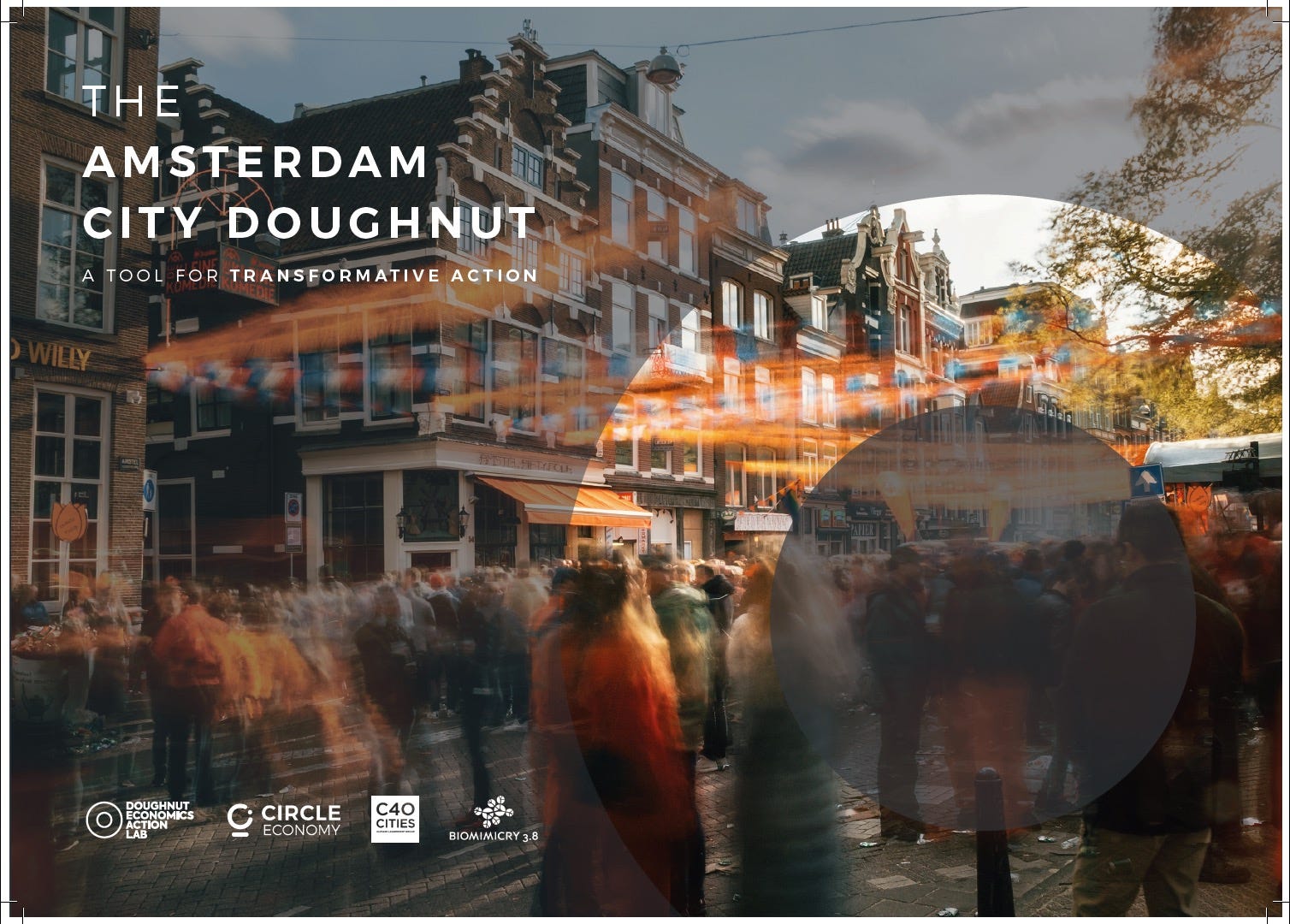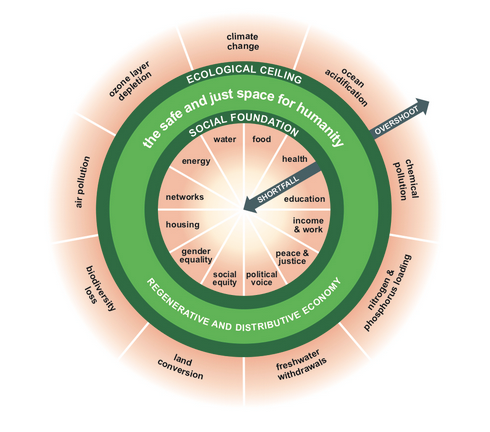Amsterdam City Doughnut- a roadmap for a thriving City
September 02, 2020 / 119409
Case Study made by Camelia Gui, 4REVS researcher (and more)

Abstract
Growth is inherent to our thinking and our economic, social and financial systems. We see growth as a fix for everything and a means to balance our society today. But this growth that we are addicted to is not a natural one. It is an infinite growth in a world of finite resources.
Is this growth really good for us and is it really the only way forward? Kate Raworth, a renegade British economist, challenges growth as a progress indicator for our society and economy. She is instead proposing the creation of thriving systems that meet the needs of all people within the needs of the planet. Systems that are ecologically and socially just.
Thriving systems, not constantly growing systems. And when she listed the indicators that describe such systems, she got a doughnut-looking dashboard. Kate pioneered this model in 2018 and it consists of 3 concentric circles, where the objective is to not allow anyone to fall short on the social foundation or go beyond the limits of the planet. We must look at it as a reference for how we shape our economical, environmental and social future. This tool and guidance that the doughnut offers can be used for just about any unit of the society. Even as the development strategy of a city.
One of the most innovative cities in the world, Amsterdam, just built their own doughnut in June 2019. By mapping the city’s objective to the global doughnut, they created the compass for a sustainable thriving city.
This is the world’s first city doughnut and it brings forward a 5 year-long development strategy. Simply put, it offers directions for a thriving city within a thriving planet.
Overall description
The Amsterdam city doughnut is first and foremost a compass for navigating circular initiatives.
Circular economy is the opposite of our today’s linear system (the take, make, waste economy) and it follows eco-design principles by designing out waste and keeping materials in use as much as possible. This type of economy has been prioritised by both the EU and China in their trade and development strategies. Recognising this potential, the Dutch government aims to become 50% circular by 2030, and fully circular by 2050. The city of Amsterdam has followed with the target of achieving a 55% cut in emissions by 2030 and 95% cut by 2050, compared to 1990 levels. Thus Amsterdam aims to be a fully circular city by 2050. To realise this ambition, systemic change is needed. And the City Doughnout enables that.
Applying principles from Kate Raworth’s Doughnut Economics, the Amsterdam City Doughnut is a pioneering and deeply collaborative process involving more than 100 officials and businesses from the city. It was created by the City of Amsterdam, Kate Raworth and the team at Circle Economy. The C40 cities network also joined. What came out of their effort is a 5 year long strategy. The process is summarised below.
In 2019, city officials from the various departments in the city and region, and stakeholders from three value chains were brought together. The co-created agenda comprised four steps:
1. Mirroring the current targets of the city (49 city goals) with the Doughnut model. Amsterdam was already mapping its resources flows and designing strategies for circularity
2. Developing holistic circular economy directions on three priority value chains recommended by recent circularity reports in the city
3. Aligning current targets to align with the ambitions in the circular economy directions and the Doughnut model
4. Validating the directions with knowledge from existing projects and city residents
For each step, a workshop was organised with the various stakeholders. The end result was a list of extensive and comprehensive 17 circular policy initiatives for Amsterdam.
It is important to note that the Amsterdam city doughnut builds upon the city’s successful 70 circular projects developed recently. And on the programs “Amsterdam Circular: Learning by doing” and the “Circular Innovation Programme”. The doughnut refines and enhances this foundation, but it also extends the city’s capabilities towards an impressive all-comprising urban development.
The motivation for the city doughnut was to create thriving cities for a thriving planet, to give city officials an analytical compass to navigate circular initiatives, but also to create a tool that all cities internationally could start using. The city of Amsterdam is the first city in the world to use the Doughnut economics model. With this model, the city is building an integral circular economy strategy for the period 2020–2025, with a forward view to 2030.
Main features or highlights
The Amsterdam Doughnut is focused on three priority value chains- Biomass and Food, Construction, Consumer Goods, as the key themes resulting from a previous report called “Amsterdam Circular: Evaluation and Action Perspectives”. Currently, the construction sector creates 40% of total municipal waste, consumer goods represent the largest environmental impact of households and one-third of all food goes to waste.
To realise circularity in these priority value-chains, 17 circular economy directions (policy initiatives) were formulated with the objective of:
- Encouraging healthy, sustainable and plant-based food consumption by all citizens
- Preventing over-consumption and minimising the use of fast-moving consumer goods
- Circular area development through flexible zoning and regenerative urban design
In the food value chain, these policies aim at:
- -creating a plant-based diet for Amsterdam residents
- bringing food closer to the city
- enabling direct connections between producers and consumers
- bringing food back to land as nutrients
For consumer goods, they will follow circular business models to extend the life of products (mostly prioritize access over ownership. E.g. — library of toys, children clothes, shared resources: living spaces or cars).
Why is this revolutionary?
- It offers a compass to navigate circular and sustainable initiatives in a city
- The Amsterdam city doughnut is setting a great example of urban innovation and co-creation
- It is a more realistic and down to Earth model for describing the cities we are living in and their future development
- It incites collaboration like no other strategy used so far in city development
- It is participatory, based on workshops with city residents (to make the doughnut rooted in and enriched by the character and culture of the city)
- Applies eco-design principles (designing out waste)
- It encompasses both social and economic challenges and objectives, while connecting the two to the environmental limits (health, work, climate, energy targets)
- Can already be replicated by city officials internationally
- It is based on local vision and owned global responsibility
If one would need to summarize the recipe for creating a city doughnut that works, it would have to be a mix of the following ingredients: a strong foundation of sustainable and successful experiments on circularity (existing or to be created), a local vision geared towards innovative and inclusive systems, openness for collaborative work and co-creation of city programs, inclusivity of all stakeholders (even citizens, not just city officials), everything supported by competent guidance and proper follow up on all set targets.
Concrete examples
Outcomes and content of the City Doughnut workshops:
- 17 policy initiatives or directions belonging to the 3 key themes: construction, food and consumer goods. All 17 directions are available in the report called Building blocks Amsterdam Circular 2019.
- Each circular direction is the work of 50 representatives from the municipality of Amsterdam. They were then validated by over 100 external stakeholders, including businesses, experts and knowledge institutions.
- Relevant enabling elements (for circular actors) and policy instruments (municipality) are presented next to each direction. The list of the enabling elements: smart sensors and technologies to collect and monitor data for mapping resources, true pricing including environmental costs (local administration in particular), innovative platforms to support partnerships, holistic thinking, living labs projects, city-wide reverse logistics, trainings and education for the labour market.
- For each direction, the following was taken into account:
- Description of the circular economy direction and itsrelevance for the city
- Main key themes in the doughnut impacted by the selected direction
- Baseline and current projects existing in Amsterdam
- Who to be involved and what to do on each part
Examples:
1. Presentation of the CONSTRUCTION key theme and one of its direction:
Direction: flexible zoning, climate adaptation and regenerative urban design
Linking of each action to the global doughnut model
Existing examples to replicate and build upon:
The Haven-Stad area, where 40,000–70,000 new houses will be built, aims for 75% reduction in CO2 emissions, emission-free mobility, rainproof districts, 50% reuse of resources and 65% waste separation.
2. Presentation of the FOOD and BIOMASS key theme and one of its direction:
Direction: Foster circular food production in urban and peri-urban areas
Linking of each action to the global doughnut model
Existing examples to replicate and build upon:
FOODLOGICA is a platform linking local food, consumers and businesses in Amsterdam’s city centre through transport that reduces emissions, congestion and pollution.

The inner boundary of the Doughnut represents the social foundation. The twelve categories are derived from internationally agreed minimum social standards, such as access to adequate water, health, and peace and justice. These standards were internationally established through the Sustainable Development Goals in 2015.
The outer boundary of the Doughnut represents the ecological ceiling of our planet. This ceiling consists of nine categories. Each category presents a threat to a system or process that is important to maintaining the stability of the planet. We cannot go beyond these limits if we want to ensure prosperity for future generations. Between the social foundation and the ecological ceiling lies a safe and just space in which humanity can thrive.
References
Main report: Building-blocks-Amsterdam-Circular-2019.pdf (19 Jun 2019) https://publish.circle-economy.com/amsterdam-city-doughnut Summary of the 2019 workshops for the city doughnut: https://www.youtube.com/watch?v=2pl-xlIKgak